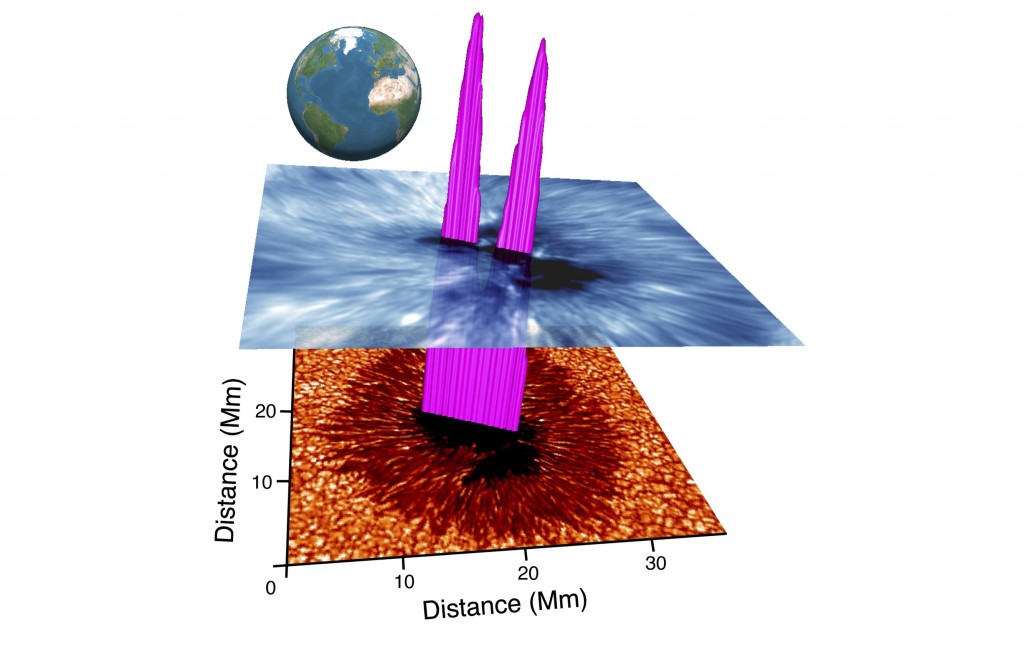CSUN Professor Helps Uncover a 60-year-old Mystery Involving the Sun

Three-dimensional visualization of the geometric extent of the chromosphere above the sunspot used in this study. The geometric extent of the chromosphere, visualized here as the pink isocontours extending upwards from the photospheric (lower image) umbra and through the chromospheric (upper blue-colored image). Photo by Damian Christian.
For more than 60 years, observations of our sun have shown that magnetic waves grow in strength as they leave the sun’s interior but there was no solid observational evidence as to why.
Damian Christian, Chair of the Department of Physics and Astronomy at California State University, Northridge is part of a team of researchers that discovered why the sun’s magnetic waves strengthen and grow as they emerge from its surface.
“I think it’s exciting,” said Christian. “We’ve been getting a lot of solar data that doesn’t show many changes, but it’s nice when all the pieces fit, and you can solve an interesting problem.”
The sun is a hot ball of gas with a surface about 10,000 times less dense than the air in a room – a temperature of about 6,000 degrees. There is a granulation pattern from the hot gas that rises through the interior convection zone into the photosphere – a star’s outer shell from which light emerges.
In the photosphere, there are dark blemishes about the size of Earth called sunspots where there is a strong magnetic field. It appears there is a heating mechanism going on from the inside of the sun, or under the surface, that’s heating this low-density gas causing an increase in temperature and decrease in density as we move away from the sun into its corona.
The corona’s high temperatures have also been a mystery. Usually the closer we are to a heat source, the warmer we feel. This is the opposite of what seems to happen on the sun – its outer layers are warmer than the heat source at its surface.
The findings, “A chromospheric resonance cavity in a sunspot mapped with seismology,” were recently published in the scientific journal Nature Astronomy.
To carry out their research, Christian and his colleagues formed a team called Waves in the Lower Solar Atmosphere (WaLSA). The research team included David Jess, Ben Snow, Scott Houston, Gert Botha, Bernhard Fleck, Krishna Prasad, Andres A. Ramos, Richard Morton, Peter Keys, Shahin Jafarzadeh, Marco Stangalini and Samuel Grant.
The team used advanced high-resolution observations from the Dunn Solar Telescope to observe the resonance cavity above a sunspot and computers to analyze the data through simulations. The resonance cavity can amplify magnetic waves – which channel energy from the sun’s interior energy reservoir up into the outer regions of its atmosphere – in the solar atmosphere, a similar effect that causes sound amplification in an acoustic guitar.
It was discovered that the wave amplification process can be attributed to the formation of an acoustic resonator where changes in temperature between the surface of the sun and its outer corona create boundaries. These boundaries act to trap the waves allowing them to intensify and grow in strength. The team also found that the thickness of the resonance activity is the main factor governing the characteristics of the detected wave motion.
The Dunn Solar Telescope is a vacuum tower telescope 300 feet tall with 100 feet above ground and 200 feet below ground. It has a mirror that picks up a view of the sun and sends it down to the main mirror and back to the digital cameras on an optical table. Space data from the NASA Solar Dynamics Observatory was also used.
“I feel very fortunate to work with my international colleagues who are some of the world leaders in solar physics research,” said Christian. “It is very exciting that we have the capability to solve mysteries of our sun with the latest cutting-edge technology.”
Plans are being made to investigate further using new generation solar telescopes including the Daniel K. Inouye Solar Telescope – a $300 million scientific facility in Hawaii.

 experience
experience